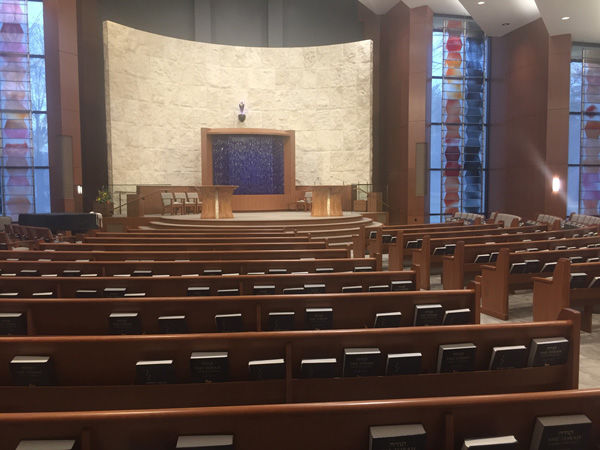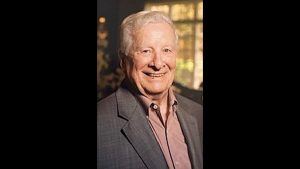Inclusion, accessibility key in synagogue renovation plans
Published January 17, 2018
The rabbi’s secretary at Congregation Shaare Emeth sometimes asked Susan Lipstein if she wanted to sit on the bimah during services.
That honor is something Jews usually look forward to. But Lipstein, who has multiple sclerosis, was “always reluctant because there were steps getting up to the bimah.”
She can get around with the assistance of a walker and is able to drive because of hand controls in her car.
ADVERTISEMENT
Still, she said, “I think about how for people who don’t have these limitations, it doesn’t occur to them that there are people who can’t do those things, and so, it’s frustrating. I’m not the kind of person who gets really depressed over that stuff; I just get annoyed.”
With those feelings in mind, the Reform congregation in Creve Coeur recently completed an $8.5 million renovation. During the planning process, the Shaare Emeth executive director asked Lipstein to participate in an inclusion committee to talk about “accessibility issues.”
The congregation renovated its sanctuary and chapel, among other areas, and now has ramps leading up to the bimah. The chairs on the platform are more comfortable, she said. There are ramps outside all three entrances to the synagogue. And the restrooms are closer to the sanctuary, among other changes.
ADVERTISEMENT
“I just feel welcome and I’m so appreciative of the fact that they listened to what it’s like to have mobility challenges,” said Lipstein.
The congregation is not alone among St. Louis synagogues in thinking about members who have difficulty moving, limited hearing or other disabilities.
A number of local synagogues are spending, or preparing to spend, millions of dollars on renovations. And leaders of those institutions frequently use words like “inclusion” and “accessibility” when explaining why they are investing large amounts of money in their buildings.
Rosalie Stein, Shaare Emeth executive director, said she heard from members “ ‘Oy, I can’t walk the steps. Oy, I can’t do this. I have to come in a wheelchair and sit in the aisle or all the way in the back of the sanctuary. It’s embarrassing.’ No, you are part of our congregation; no barriers.”
Joshua Zinder, an architect with Landau Zinder, a firm in New Jersey that specializes in synagogue design, told Moment magazine last year that the “single biggest thing that we get asked to do is, ‘How can we make our building handicap-accessible?’ ”
Traditional Congregation in Creve Coeur is preparing to spend $1 million on renovations, much of it to its Jewish Heritage Center, a classroom space. That includes replacing its cinder block walls with drywall and adding new floors and lighting.
The renovation also means adding additional ramps to the front entrance and a unisex restroom that is certified under the Americans with Disabilities Act. There are smaller renovations to comply with the A.D.A., like adjusting the height of the kitchen counters, and other changes, like adding a brick garden for aesthetic reasons and to honor donors.
“We want to make our facility more up-to-date in terms of accessibility, and just more attractive,” said Marian Gordon, executive director of Traditional Congregation.
Gyo Obata, the renowned St. Louis architect, designed Congregation B’nai Amoona’s building on Mason Road in the 1980s. He delivered the synagogues signature element with the tiered blue glass atop of the sanctuary. “While no one has ever designed a perfect building, Mr. Obata came pretty close,” Bernard Lipnick, the late B’nai Amoona rabbi, wrote in a book about the architect.
Still B’nai Amoona Rabbi Carnie Rose recalls hearing via Lipnick that Obata once said, “If I had designed this building 20 years” later, “I never would have built it the way I built it because it’s not accessible and it becomes irrelevant to members who can’t make their way up the very steep steps (to the bimah),” Rose said. The congregation has since lowered its bimah, installed ramps and added electronic door openers to the sanctuary, among other modifications. In 2013, the Ruderman Family Foundation awarded the congregation $50,000 to continue its disability inclusion efforts. Now the congregation is discussing spending $7 to $10 million to renovate its chapel and Early Childhood Center, widen a passage in the building and increase the size of a parking lot to bring it closer to the main entrance, among other proposed changes.
The congregation would like to use only one entrance to the building for security reasons. Bringing the parking lot closer to that doorway, obviously, makes for a shorter walk.
Still, Rose said the idea for the renovations “started with the youth and not with the elderly.”
“I think there is an unfortunate observation that the Jewish community is aging — and in many ways it is,” Rose said. “But there is also very much a concern” at B’nai Amoona “about access for young people of all ages and stages and able-bodied and less able-bodied.”
Older Jewish adults are in some sense the mainstays of the American Jewish community. According to a 2013 study from the Pew Research Center, 93 percent of American Jews born from 1928 to 1945 identify themselves as “Jews of religion” compared with 68 percent of millennial Jews. (The alternative category in the study is “Jews of no religion.”)
The proposed changes at B’nai Amoona, such as updating the childcare center, are centered on the idea of “creating spaces not just for today but for generations to come,” said President Andrew Oberman. The congregation hopes to start construction in the next six months.
Kol Rinah has faced concerns from congregants not about their old building — but plans for their new one. In 2015, the Conservative congregation in University City agreed to exchange its building for a space in Clayton owned by the Journey Christian Church. Some congregants have asked, where will we park?
“It’s something we have heard a lot about, but the trade-off is we get to have a Jewish congregation in the heart of an urban area, and that’s something we’re really, really excited about,” said Dave Cooperstein, an architect and Kol Rinah board member.
“We have a parking strategy that gives us more spaces than we have in our existing building,” he added. That means 24 spaces at the building that the congregation could designate as handicapped parking, parking on the street and a lot across the street for 170 spaces that the congregation will reserve from Friday night to Sunday night. There is also a large lane to drop people off in front of the building, he said.
Kol Rinah hopes to move into its new space in spring 2019. But first comes building a new sanctuary and renovating the building to foster “extreme accessibility of all kinds,” said Randi Mozenter, Kol Rinah president. During the planning process, Mozenter, a therapist, met with a former congregant who had moved to the East Coast and had significant mobility issues.
“I met with her specifically to really look at what she needs to be able to worship in a totally accessible, comfortable way….We didn’t want to just hit the big things like stairs; we want to hit all different things, like, what height do things need to be? We are very aware of A.D.A. standards, but we wanted to go a step further,” she said. For example, the congregation is also taking into consideration the height of bookshelves and coat racks.
And like other congregations, Kol Rinah isn’t just worried about older adults. Mozenter said she had just met with architects and asked them to increase the width of all doorways to 48 inches to accommodate a double-wide baby stroller.
“For us, accessibility isn’t just about catering to the elderly or the physically-challenged,” said Cooperstein “It’s about accepting everybody and bringing people of all ages to the building because the only way congregations are going to grow is if they can attract younger congregants.”
















